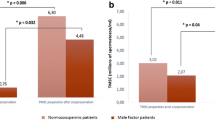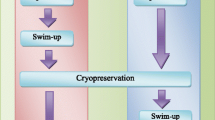Purpose
This prospective study compared the effects of four sperm preparation methods on semen samples with normal sperm parameters. The samples were obtained from husbands of infertile couples being evaluated at a fertility center in New York City. Twenty-nine of 51 men in the study (56.9%) had fathered a child within the past 2–5 years. Specifically, the study compared the effects of simple wash (unselective) and three selective methods—conventional swim-up, three-gradient Percoll separation, and swim-up from the Percoll-separated fraction—on the concentration, percentage motile, percentage normal (oval) morphology, percentage intact acrosomes, percentage motile sperm recovery, and motile sperm concentration in the processed samples. The same parameters were measured in the untreated ejaculate, resulting in five data sets. These data were analyzed by both comparison across the five sets and pairwise multiple comparisons between sets.
Results
The study showed that of the selective methods, conventional swim-up and Percoll separation yielded comparably optimal percentages motile sperm recovery and motile sperm concentrations.
Conclusion
However, swim-up yielded a significantly higher percentage oval and percentage motile sperm than Percoll, while Percoll had a significantly higher percentage acrosome-intact. Swim-up after Percoll separation yielded the highest percentage motility and percentage oval but had the lowest motile sperm concentration with the lowest percentage acrosome-intact.
Similar content being viewed by others
References
Rogers BJ, Bentwood NJ, van Campen H, Helmbrecht G, Soderdahl D, Hale RW: Sperm morphology assessment as an indicator of human fertilizing capacity. J Androl 1983;4:119–125
Kruger TF, Menkveld R, Stander FSH, Lombard CJ, van der Merwe JP, van Zyl JA, Smith K: Sperm morphologic features as a prognostic factor in in-vitro fertilization. Fertil Steril 1986;46:1118–1123
Kruger TF, Acosta AA, Simmons KF, Swanson FJ, Matta JF, Oehninger S: Predictive value of abnormal sperm morphology in in-vitro fertilization. Fertil Steril 1988;49:112–117
Baker HWG, Ng FLH, Liu DY: Preparation and analysis of semen for IVF/GIFT.In Handbook of in Vitro Fertilization, A Trounson, DK Gardner (eds). Boca Raton, FL, CRC Press, 1993, pp 33–57
Liu DY, Baker HWG: The proportion of human spermatozoa with poor morphology but normal intact acrosomes detected withPisum sativum agglutinin correlates with fertilization in vitro. Fertil Steril 1988;50:288–293
Cross NL, Morales P, Overstreet JW, Hanson FW: Two simple methods for detecting acrosome-reacted human sperm. Gamete Res 1986;15:213–226
Ng FLH, Liu DY, Baker HWG: Comparison of Percoll, mini-Percoll and swim-up methods for sperm preparation from abnormal semen samples. Hum Reprod 1992;7:261–266
Kruger TF, Ackerman SB, Simmons KF, Swanson RJ, Brugo S, Acosta AA: Quick reliable staining technique for sperm morphology. Arch Androl 1987;18:275–277
World Health Organization: Laboratory Manual for Examination of Human Semen and Semen-Cervical Mucus Interaction, 3rd ed. Cambridge, Cambridge University Press, 1992
Katz DF, Diel L, Overstreet JW: Differences in the movement of morphologically normal and abnormal human seminal spermatozoa. Biol Reprod 1982;26:556–570
Liu DY, Lopata A, Johnston WIH, Baker HWG: Human sperm-zona binding, sperm characteristics and in-vitro fertilization. Hum Reprod 1989;4:696–701
Tesarik J: Appropriate time of the acrosome reaction is a major requirement for the fertilizing spermatozoa. Hum Reprod 1989;4:957–961
Liu DY, Baker HWG: Tests of human sperm function and fertilization in vitro. Fertil Steril 1992;58:465–483
Weissenberg R, Eshkol A, Rudak E, Lunenfeld B: Inability of round acrosomeless human spermatozoa to penetrate zona-free hamster ova. Arch Androl 1989;11:167
Liu DY, Baker HWG: Morphology of spermatozoa bound to the zona pellucida of human oocytes that failed to fertilize in vitro. J Reprod Fertil 1992;94:71–84
Makler A: Modern methods in semen analysis evaluation.In Progress in Infertility, SJ Behrman, RW Kistner Jr, GW Patton (eds). Boston, Little, Brown, 1998, pp 633–661
Poussette A, Akerlof R, Rosenberg L, Fredricsson B: Increase in progressive motility and improved morphology of human spermatozoa following their migration through Percoll gradients. Int J Androl 1986;9:1–13
Andolz P, Bielsa MA, Genesca A, Benet J, Egozcue J: Improvement of sperm quality in abnormal semen samples using a modified swim-up procedure. Hum Reprod 1987;2:99–101
Le Lannou D, Blanchard Y: Nuclear maturity and morphology of human spermatozoa selected by Percoll density gradient centrifugation or swim-up procedure. J Reprod Fertil 1988;84:551–556
Mortimer D, Curtis EF, Camenzind AR, Tanaka S: The spontaneous acrosome reaction of human spermatozoa incubated in vivo. Hum Reprod 1989;4(1):57–62
Author information
Authors and Affiliations
Additional information
This study was undertaken on patients undergoing fertility evaluation and treatment at the Brandeis Fertility Center. There was no outside support in the form of financial aid, grants, or equipment.
Rights and permissions
About this article
Cite this article
Brandeis, V.T., Manuel, M.T. Effects of four methods of sperm preparation on the motile concentration, morphology, and acrosome status of recovered sperm from normal semen samples. J Assist Reprod Genet 10, 409–416 (1993). https://doi.org/10.1007/BF01228091
Received:
Accepted:
Issue Date:
DOI: https://doi.org/10.1007/BF01228091




